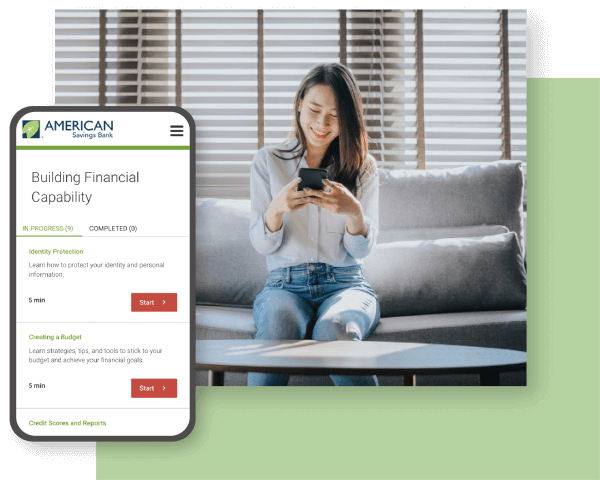Banking Basics for Teens
By
ASB January 30, 2024 | 5 min read PersonalPICTURE THIS: You’re about to start a summer job and your boss asks you for your bank information so you can deposit your paycheck right into your bank account. If you don’t have a bank account, you’ll have to wait to cash your paycheck. You might be wondering, can a teenager have a bank account at all? The answer is yes!
Bank accounts are essential to managing your money, and opening an account as a teen is a great way to build good money habits for the future. At American Savings Bank, we know bank accounts can seem a little intimidating. Keep reading to learn about different account types and how to manage your money with banking tools like mobile wallet and Online Banking.

ACCOUNT TYPES: CHECKING AND SAVINGS
Not all bank accounts are the same. Different types of bank accounts give you access to different benefits and features. As a teen, you may not need more than one type of account to manage your finances. As you get older, your money situation will likely become more complicated, requiring you to maintain more than one account type. The two most basic bank account types for teens are:
CHECKING ACCOUNTS
An account that’s made to keep your money safe while making it easy to access. The money in your checking account is accessible when you need it through debit cards, ATM cash withdrawals or paper checks.- SAVINGS ACCOUNTS
An account that’s designed to keep your money safe for the long run . Most savings accounts, however, earn interest, which is money the bank pays you for putting and keeping money in the savings account. Interest can help to grow your savings over time. A savings accounts is great for saving for a big purchase you want to make in the future — like your first car or a new cell phone.

HOW CAN A TEENAGER OPEN A CHECKING OR SAVINGS ACCOUNT?
Teenagers can visit their nearest ASB Branch to open a joint checking or savings account with a parent or guardian.
HOW TO USE ONLINE BANKING
Online Banking is an easy and convenient way to manage your money and make basic transactions in your checking and savings accounts. Once you have an ASB account, you can sign up for Online Banking, which lets you:
See your current balance and transactions such as debit card purchases on your checking account
Access account statements
Deposit checks using the ASB Hawaii Mobile App
Transfer money between your ASB bank accounts
Sign up for eStatements so you no longer get a paper statement in the mail
- Set up alerts to notify you about your account activity like transactions or security concerns
Online banking for teens is the best way to go when opening a new bank account!
HOW TO READ YOUR BANK STATEMENT
Each month, your bank will send you a bank statement with details about your bank accounts. This will list your account type and every transaction you’ve had since your last statement. It’s important to go over your bank statement as soon as you get it; carefully reading through your transactions can help you spot inaccuracies or fraud. For example, if you notice a debit card purchase that you didn’t make and think is fraudulent, you should contact your bank as soon as possible.
ARE YOU A TEEN LOOKING TO OPEN A BANK ACCOUNT?
Whether you’re starting your first job or heading to college, having a bank account is one of the easiest ways to manage your money. The earlier you get started, the more time you have to learn good banking and money management habits. Learn more about banking and our checking account options today.
Nothing contained in this material is intended to constitute legal, tax, securities or investment advice, nor an opinion that it is appropriate for readers. The information that is contained in this material is general nature. Readers should seek professional advice for their respective situations.

Free ASB Financial Education Course:
Checking Accounts
Learn about the features, benefits, and functions of checking accounts.
Take Course >




